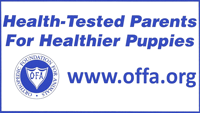Orthopedic Concerns
While Appenzellers tend to be sturdy dogs, they can face some problems with their bones and legs. Perhaps the most debilitating diseases currently facing the Appenzeller are orthopedic in nature. While efforts to eradicate these diseases have been on the rise in recent years, Appenzeller breeders still have a way to go before these problems have been completely eliminated.
HIP DYSPLASIA
This condition is primarily thought of as affecting large breeds, but it can occur in smaller dogs as well. Hip dysplasia, or HD, occurs when the head of the femur (thigh bone) doesn't fit properly in the cup (acetabulum) of the hip joint. When the cup is too shallow, the joint is lax, meaning that the bone slips around inside it instead of fitting securely. There are many factors, including genetics, environment and nutrition that contribute to this deformity of the hip joint. Research on larger breeds has shown that switching to adult food early in a puppy's life (12 to 16 weeks), avoiding supplements and keeping the puppy thin as it is growing will minimize its chance of being affected.
Diagnosis
Hip dysplasia is diagnosed through x-rays. It can range from mild to severe, with some dogs never showing signs and others developing lameness at an early age. Take your dog to the veterinarian if you see him limping after exercise, walking with a waddling gait, having trouble getting up or lying down, or showing reluctance to move.
Treatment
Mild cases of hip dysplasia can be treated with anti-inflammatory drugs and nutraceuticals, plus moderate exercise to encourage muscle mass and tone. In severe cases, however, surgery — ranging from making minor changes in the shape of the femur to total hip replacement — is the only way to relieve the dog's pain.
The development of hip dysplasia depends on multiple factors, both genetic and environmental. If both parents are free of hip dysplasia, there's a much greater chance that their offspring won't have hip problems. Keeping your dog on a proper diet and minimizing weight gain can help reduce the risk of hip problems as well. Rapid growth hastens the development of orthopedic problems. It can also make problems more severe than they might have been otherwise, so don't let your Appenzeller puppy get fat. To prevent injury, provide non-skid footing such as area rugs if you have slick wood or tile flooring.
PATELLA LUXATION
This involves the stifle or knee joint. The patella or kneecap usually rides up and down in a groove on the front of the knee. With this condition, the knee-cap slides to the side (usually the inside) and the joint is unstable. When the kneecap is out, the dog may limp and carry the leg. The dog can often stretch his leg back and pop the patella back in himself. Some dogs are normal when young and develop this with age. Many dogs live their lives with this but some require surgery to deepen the groove and reposition the patella so it stays in place. One or both legs may be affected.
ELBOW DYSPLASIA
The Three Faces of Elbow Dysplasia
Elbow dysplasia is a general term used to identify an inherited polygenic disease in the elbow of dogs. Three specific etiologies make up this disease and they can occur independently or in conjunction with one another. These etiologies include:
-
Pathology involving the medial coronoid of the ulna (FCP)
-
Osteochondritis of the medial humeral condyle in the elbow joint (OCD)
-
Ununited anconeal process (UAP)
Studies have shown the inherited polygenic traits causing these etiologies are independent of one another. Clinical signs involve lameness which may remain subtle for long periods of time. No one can predict at what age lameness will occur in a dog due to a large number of genetic and environmental factors such as degree of severity of changes, rate of weight gain, amount of exercise, etc. Subtle changes in gait may be characterized by excessive inward deviation of the paw which raises the outside of the paw so that it receives less weight and distributes more mechanical weight on the outside (lateral) aspect of the elbow joint away from the lesions located on the inside of the joint. Range of motion in the elbow is also decreased.
ORTHOPEDIC FOUNDATION FOR ANIMALS (OFA)
The Mission of the OFA is to promote the health and welfare of companion animals through a reduction in the incidence of genetic disease
The OFA is guided by the following four specific objectives:
-
To collate and disseminate information concerning orthopedic and genetic diseases of animals.
-
To advise, encourage and establish control programs to lower the incidence of orthopedic and genetic diseases.
-
To encourage and finance research in orthopedic and genetic disease in animals.
-
To receive funds and make grants to carry out these objectives.
For more information on OFA, please visit their website: http://www.offa.org/about.html
or click on the following sticker:

